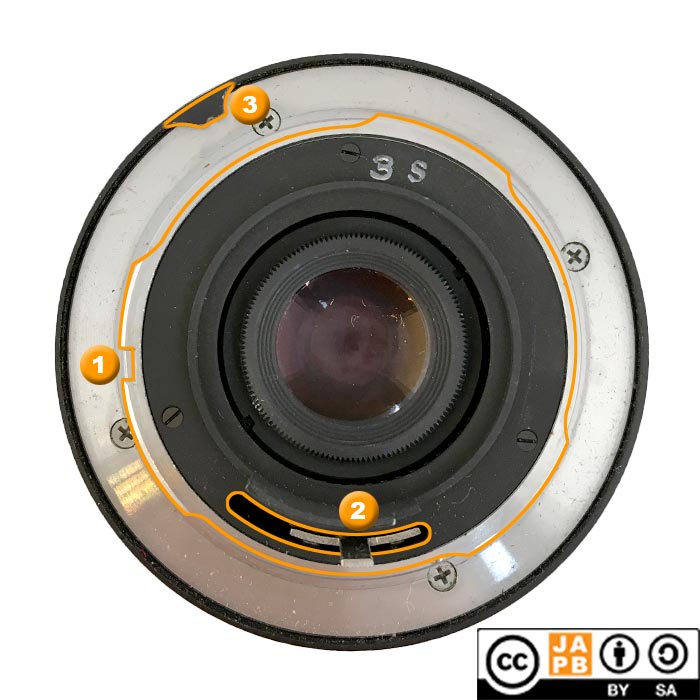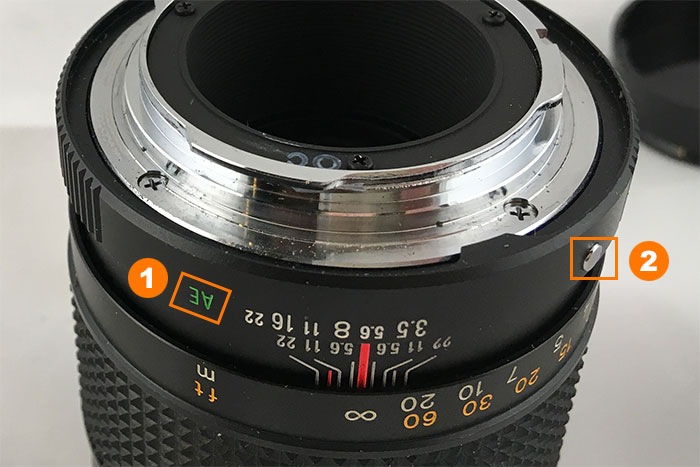Konica AR mount specifications and identification
Mount type: Bayonet (lens release on body)
Flange focal distance: 40,5 mm
Film format: 36mm x 24mm (‘Full frame’)
Mount communication: one lever for stopping down the lens for taking the shot (camera-to-lens); one prong on the aperture ring to indicate whether the lens has been set in AE/EE mode.

Key characteristics of the mount of Konica AR lenses:
[1] Three-pronged bayonet with locking notch at 09:00.
[2] Combined stop-down lever and aperture indicator (moves with aperture ring).
[3] Indicator for whether lens is set into EE/AE mode.
Information on the Konica AR mount:
If you’re new to photography, the name Konica might not register. Otherwise, you will certainly not need to be told of Konica’s once stellar reputation or of the many ground-breaking innovations Konica was first to introduce.
The Konica AR mount is a relatively long-lived (1967-1987) lens mount for Konica SLR cameras. The Konica AR mount replaced the preceding (and more short-lived) Konica F mount. The Konica AR and F mounts are not in any way compatible, even though the AR mount initially inherited a lot of the Konica F mount’s lenses.
Interestingly, Konica was relatively prescient in its 1960’s design of the AR mount, as its interface was able to cater to all the needs (such as shutter-priority or program auto) of the next two decades in stride. While many Konica lenses went through several modifications and improvements throughout their lifespan, the Konica AR mount remained unchanged for its entire existence.
The sad fact is, that due to reasons largely unrelated to the quality of its lenses, Konica was one of those otherwise venerable makers of manual focus cameras, that did not manage the transition to autofocus. To my knowledge, Konica never even tried to market an autofocus SLR. Thus, the Konica AR mount was Konica’s final lens mount. Konica stayed in the camera business, making viewfinder/compact cameras and even a rangefinder of some repute, and only re-entered (after a fashion) the SLR business in 2003, through a merger with Minolta. In some minor form, Konica lives on in the form of Sony (which took over from KonicaMinolta in 2006).
While the Konica AR mount was never as popular among third-party lens makers as, say, Canon FD or Pentax K, and although Konica did not churn out as many different lenses for its mount as e.g. Canon did (during largely the same period), the Konica AR mount nevertheless sports a full range of lenses, especially among fixed focal length lenses (primes). Also, while Konica did not emphasise zooms as much as some competitors did, the mount sported a number of both consumer and pro zooms in all the typical focal length ranges (for that period).
Many legacy lens aficionados appreciate the fact that Konica held on to metal lens construction long after most rivals had gone into plastics (in the final days, some Konica-branded plastic lenses were introduced, but these were short-lived and quite rare). Konica lenses – even the later ones which did utilise plastic or rubber, are typically sturdy, reliable constructions.
Adapting Konica AR lenses:
Konica AR lenses are fully manual lenses, and both focus and aperture are controlled by dedicated rings. Thus Konica AR lenses function perfectly on any full-frame mILC, using a cheap dumb adapter.
With mILC’s using smaller-than full-frame sensors, Konica AR lenses can be more of a mixed bag, as no focal reducers for Konica AR lenses are currently available. Many of Konica’s moderate wide, standard and short telephoto primes are perfect candidates for use on APS-C mILC’s without focal reducer, but genuine wide-angle performance remains a sore point on APS-C (and smaller) mILC’s.
The few genuine (albeit, minor) ‘gripes’ that many have regarding using adapted Konica AR lenses, are both related to the function of the aperture ring (and affected original Konica Film SLR users similarly):
• Firstly, the ring ‘clicks’ are usually quite pronounced (making moving the aperture ring less smooth as, say with Canon FD lenses), thus making de-clicking a Konica AR lens a tempting proposition also for still photographers.
• Secondly, alike many lenses of its era, Konica AR lenses supported giving the camera body control of the aperture, which was done through twisting the aperture ring past the smallest aperture, into a range indicated as EE or AE (depending on the era of the lens). Problematically, you can enter this range accidentally (assuming you are not in tune with your lens), and once you’ve reached EE/AE, the aperture ring locks and you need to decisively press a button to regain normal operation of your Konica AR lens aperture ring.
Compared to e.g. Canon FD lenses (which also had an auto-lock setting on their aperture rings), the main difference (and point in Konica’s disfavour) is that with Konica AR lenses, you can accidentally lock the aperture ring simply by twisting it past max aperture, whereas with FD lenses, you had to press the auto-lock button both to enter and exit auto-lock mode.

[1] Once aperture ring is turned to AE (or EE on older lenses) position, the aperture ring locks at minimum aperture.
[2] Button, depressing of which releases aperture ring to allow normal movement.
The Konica AR mount is special in that it – of all 36×24 mm (‘full-frame’) reflex cameras – has the shortest flange focal distance (40,5 mm). Historically, this has seriously hampered the attractiveness of Konica AR lenses, as – prior to the advent of full-frame mILC’s the only way to use a Konica AR lens as intended, has been to use it on a Konica Film Camera (production of which ceased in 1987). Resultingly, prices for Konica AR lenses was seriously under-representative of their quality for a long time, and have only recently returned to echo their photographic potential. While this warms the hear of any real Konica fan, it is less welcome news for those collectors, hoarders and other sufferers of gear acquisition syndrome who do not yet have all the Konica lenses they’d want.
More information on the Konica AR system:
• Andreas Buhl’s fantastic site
• Jean-Jacques Granas’ fantastic database